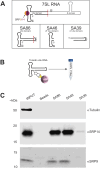Identification of a minimal Alu domain required for retrotransposition
- PMID: 40568936
- PMCID: PMC12199147
- DOI: 10.1093/nar/gkaf526
Identification of a minimal Alu domain required for retrotransposition
Abstract
Alu elements are primate-specific retrotransposons that comprise ∼11% of human DNA. Alu sequences contain an internal RNA polymerase III promoter, and the resultant Alu RNA transcripts mobilize by a replicative process termed retrotransposition, which requires the long interspersed element-1 open reading frame 2-encoded protein (ORF2p). Here, we used HeLa cell-based retrotransposition assays to define a minimal Alu domain necessary for retrotransposition. We demonstrate that Alu transcripts expressed from a cytomegalovirus (CMV) RNA polymerase II promoter can efficiently undergo retrotransposition. The use of an external CMV promoter to express Alu RNA allowed us to construct separation-of-function mutations to examine the effects of large deletions within the Alu sequence on retrotransposition. Deletion mutagenesis demonstrated that a 46-nucleotide (nt) domain located at the 5' end of the Alu RNA transcript is necessary for retrotransposition. Consistent with current models, the 46-nt 5' Alu domain associates with SRP9/14 in HeLa-HA cell extracts and can promote retrotransposition in HeLa-HA cells. We propose that the 46-nt 5' Alu domain forms a discrete structure that allows for SRP9/14 binding and ribosomal association, thereby allowing the Alu poly(A) tract to compete with the L1 poly(A) tail for ORF2p RNA binding to mediate its retrotransposition.
© The Author(s) 2025. Published by Oxford University Press on behalf of Nucleic Acids Research.
Conflict of interest statement
J.V.M. is an inventor on patent US6150160, was a paid consultant for Gilead Sciences, serves on the scientific advisory board of Tessera Therapeutics Inc. (where he is paid as a consultant and has equity options), and has licensed reagents to Merck Pharmaceutical. He also recently served on the American Society of Human Genetics Board of Directors. The other authors do not declare competing interests.
Figures





Update of
-
Identification of a minimal Alu domain required for retrotransposition.bioRxiv [Preprint]. 2024 Dec 16:2024.12.16.628748. doi: 10.1101/2024.12.16.628748. bioRxiv. 2024. Update in: Nucleic Acids Res. 2025 Jun 20;53(12):gkaf526. doi: 10.1093/nar/gkaf526. PMID: 39868163 Free PMC article. Updated. Preprint.
References
MeSH terms
Substances
Grants and funding
LinkOut - more resources
Full Text Sources
Research Materials

